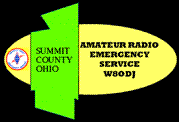|
|
NIMS/ICS Training Requirements
The
following courses are identified in the Ohio National Incident
Management System Implementation Guidance (FFY 2006) as requirements
for eligibility for federal funding in FFY 2007.
The current required courses are available for no charge as on-line independent study courses at:
http://www.training.fema.gov/EMIWeb/IS/crslist.asp.
http://www.training.fema.gov/EMIWeb/IS/crslist.asp.
The Ohio Section of ARRL requires that all Emergency Coordinators and above complete IS-100, IS-200, IS-700 and IS-800. Summit County Emergency Management Agency (EMA) requires a minimum of completion of IS-100 and IS-700 to be eligible to be stationed in the Emergency Operations Center (EOC) Radio room. All ARES members are strongly encouraged to complete all 4 of these IS courses.
COURSE DESCRIPTIONS
IS-100 (ICS 100) Introduction to the Incident Command System (ICS)
IS-100 (ICS 100) is designed to give an introduction to the principles,
common terminology and position responsibilities when responding to
an event using ICS.
The course specifically discusses major ICS functions and their primary
responsibilities, ICS organizational units, span of control, major
incident facilities and the function of each, what an Incident Action
Plan is and how it is used, and the common responsibilities
associated with incident assignments from the response perspective.
Ohio NIMS implementation plan requires this course, in addition to IS-700,
for all Federal/State/Local/Private Sector and Nongovernmental
personnel including:
- Entry level first responders & disaster workers
- Emergency Medical Service personnel
- Firefighters
- Hospital staff
- Law Enforcement personnel
- Public Health personnel
- Public Works/Utility personnel
- Skilled Support Personnel
- Other emergency management response, support, volunteer personnel at all levels
IS-200 (ICS 200) Basic ICS
IS-200 (ICS 200) has been developed to compliment the IS-100 (ICS 100)
Course. IS-200 (ICS 200) is designed to identify ICS features and
principles, describing in more detail elements such as:
- Establishment & Transfer of Command
- Management by Objectives
- Unified Command
- ICS Management Functions
- Organizational Flexibility
- Unity and Chain of Command
- Span of Control
- Incident Action Plans
- Resource Management
- Common Terminology and Clear Text
- Integrated Communications
- Personnel Accountability
Ohio NIMS implementation plan requires this course, in addition to IS-700
and IS-100, for all Federal/State/Local/Private Sector and
Nongovernmental supervisors including single resource leaders, field
supervisors and other emergency management/response personnel that
require a higher level of ICS/NIMS Training.
IS-700 NIMS: An Introduction
IS-700 explains the purpose, principles, key components and benefits of NIMS.
The course also contains "Planning Activity" screens giving you an opportunity to complete some planning tasks during this course.
- Key concepts and principles underlying NIMS
- Benefits of using ICS as the national incident management model
- Appropriate to institute an Area Command
- Appropriate to institute a Multi-agency Coordination System
- Using a Joint Information System (JIS) for public information
- Ways in which NIMS affects preparedness
- How NIMS affects how resources are managed
- Advantages of common communication and information management systems
- How NIMS influences technology and technology systems
- The purpose of the NIMS Integration Center
Ohio NIMS implementation plan requires this course for all local
government personnel including elected and non-elected officials and
administrators potentially involved in making decisions and assisting
declarations, search warrants, laws or decisions that may affect
public movement, finance & procurement, Incident Command, etc.
More specifically, the following executives should participate in
NIMS training:
- County Commissioners/Administrators
- Mayors
- City Managers
- City/Village Councils
- Township Trustees and Administrators
- Finance Directors and Appropriate Staff
- Judges (who may act as described above)
- Other personnel who may act as described above
IS-800 NRP: An Introduction
The National Response Plan, or NRP, specifies how the resources of the
Federal Government will work in concert with State, local, and tribal
governments and the private sector to respond to Incidents of
National Significance. The NRP is predicated on the National Incident
Management System, or NIMS. Together the NRP and the NIMS provide a
nationwide template for working together to prevent or respond to
threats and incidents regardless of cause, size, or complexity.
IS-800
introduces the concept of operations upon which the plan is built,
roles and responsibilities of the key players, and the organizational
structures used to manage these resources. The NRP provides a
framework to ensure that we can all work together when our Nation is
threatened.
IS-800 is designed to:
- Describe the purpose of the NRP
- Help locate information within the NRP
- Describe the roles and responsibilities of entities as specified in the NRP
- Identify the organizational structure used for NRP coordination
- Describe the field-level organizations and teams activated under the NRP
- Identify the incident management activities addressed by the NRP
Ohio NIMS implementation plan requires this course, in addition to IS-700,
IS-100 and IS-200, for all Federal/State/Local/Private Sector and
Nongovernmental all middle management as well as all command and
general staff personnel.
Middle management personnel include strike team leaders, task force leaders,
unit leaders, division/group supervisors, branch directors and
multi-agency coordination system/emergency operations center staff.
Command and general staff personnel include select department heads with
multi-agency coordination system responsibilities, area commanders,
emergency managers and multiagency coordination system/emergency
operations center managers.
